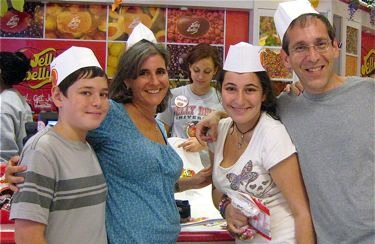 50 days after Yom Kippur, on the 29th day of the Hebrew month of Heshvan, thousands of Jewish immigrants from Ethiopia converge on our southern Jerusalem neighborhood. This year, my wife Jody and I joined them.
50 days after Yom Kippur, on the 29th day of the Hebrew month of Heshvan, thousands of Jewish immigrants from Ethiopia converge on our southern Jerusalem neighborhood. This year, my wife Jody and I joined them.
The gathering is for the Sigd festival, a holiday that symbolizes the acceptance of the Torah at Mount Sinai. Sigd – which comes from the Amharic word for prostration and is also one of two Ethiopian Jewish terms for synagogue – is unique to the Ethiopian community and this year was declared by the Knesset to be a national Israeli holiday.
When the festival was held in Ethiopia, there was a clear longing to return to Jerusalem. Now that 80 percent of the community is in Israel – a total of more than 120,000 – the Sigd gathering is held on the picturesque Haas Promenade with its stunning view of the Old City. Tens of buses bring Ethiopians in from all over Israel to participate.
Central to the ceremony is a raised stage where the Kesim, the spiritual leaders of the Ethiopian Jews, lead the crowd in communal prayer.
Sigd is quite a spectacle to outsiders like Jody and me. The Kesim are decked out in traditional white robes and stand under multi-colored umbrellas while chanting the Torah and other blessings in a repetitive atonal cadence punctuated by a few familiar words (we were able to make out “Jerusalem†and “Adonaiâ€).
The congregation itself is divided into two types – elders, many of whom were similarly garbed to the Kesim, and their children and grandchildren who dressed entirely Israeli and appeared to be more interested in the social scene than its religious undertones.
The older immigrants were a diverse bunch: women with colorful head scarves tossing white woolen shawls over their shoulders as if they were tallitot; several men in black suits donning tefillin (a Talmudic custom not known in Ethiopia where Jewish texts only went as far as the Bible); and everywhere a sea of kippot, hats, baseball caps and more umbrellas.
The youth were also not all of one type. There were girls dressed in national religious garb – long skirts and sleeves – and others in tight jeans and low tops. The boys spanned a similar range from religious to rebellious.
That rebellion is one of the less positive aspects of the Ethiopian aliyah. I would like to say that Israel has learned from the discrimination the Ashkenazi pioneers meted out on Sephardi immigrants from Arab countries following the state’s establishment. Unfortunately, the Ethiopians got an even sharper end of a bad stick.
There’s a sad joke that goes something like this: The Ashkenazim look down on the Sephardim, the Sephardim look down on the Russians, and everyone looks down at the Ethiopians.
The younger generation is perhaps the hardest hit. Not knowing where they fit in, segregated into slums with poor schools, crime, drugs and alcohol, and facing an enormous generation gap with their mostly illiterate rural parents, it’s not surprising that many Ethiopians feel alienated and resentful.
The irony is that, while the rest of the world is running to embrace multi-culturalism, Israel – at least as far as the Ethiopian community is concerned – is still pushing an aggressive melting pot as a primary value.
My friend and journalist Ruth Mason wrote an article for The Jerusalem Post a few years ago that painted a bleak picture. Immigrants from Ethiopia make up the poorest Jewish subgroup in Israel, she said, “with 70 percent living under the poverty line.†Ethiopian pupils complain that they can’t progress like their peers who have “private tutors when they need them and have parents who can help them with homework. It’s frustrating.â€
But the picture isn’t entirely hopeless, Ruth adds. Government and non-profit organizations have invested billions of shekels into trying to ease the absorption process. The Jerusalem Conservatory of Music and Dance, for example, gives full scholarships to promising Ethiopian youngsters.
Perhaps the Ethiopian experience in Israel should be seen as the experience of Jewish immigrants worldwide. My grandfather came to the U.S. from Romania at the beginning of the last century. He was traditional (though not what we’d call Orthodox today). His son (my father) moved away from tradition, and I didn’t re-discover my roots until I was a young adult. My own children were raised in Israel with a solid Jewish upbringing.
The same may be true for the Ethiopian community in Israel. The current generation is like my father, eager to shake off traditions perceived as belonging to an older, irrelevant world. Their children may be more interested in reconnecting with their Ethiopian heritage.
It is now the responsibility of the Kesim and those young people who are already willing to listen, to ensure that, when the next generation is ready, the Sigd will still be around to receive them.

